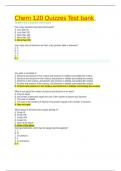Chem 120 Quizzes Test bank
Multiple-choice Questions with answers
How many elements have been discovered?
A. Less than 50
B. Less than 100
C. More than 100
D. More than 200
C. More than 100
How many rows of elements are there in the periodic table of elements?
A. 5
B. 8
C. 4
D. 7
D. 7
0:07
/
0:54
6 Ways to Show Appreciation for Your Child's Teacher
Any atom is consisted of..
A. Electrons and protons in the nucleus and neutrons in orbitals surrounding the nucleus
B. Electrons and neutrons in the nucleus, and protons in orbitals surrounding the nucleus
C. Electrons in the nucleus, and protons and neutrons in orbitals surrounding the nucleus
D. Protons and neutrons in the nucleus, and electrons in orbitals surrounding the nucleus
D. Protons and neutrons in the nucleus, and electrons in orbitals surrounding the nucleus
What is true about the number of protons and electrons in an atom?
A. they are equal
B. the number of electrons equals the sum of the number of protons and neutrons
C. They are not related
D. The sum of the numbers of electrons and protons equals to the number of neutrons
A. they are equal
Which group of elements does oxygen belong to?
A. Group IA
B. Group VIB
C. Group VIIA
D. Group IVA
E. None of the above
E. None of the above
Among all elements, which has the largest electronegativity?
A. C
B. O
C. He (helium)
D. F
E. Fr (Francium)
D. F
, Do electro negativities of elements in a row of the element table follow a trend? If yes, describe the trend.
A. Yes, they decrease from left to right
B. Yes they increase from left to right
C. No trend
D. Yes for some rows, no for other rows
B. yes, they increase from left to right
How many subtle an atom can have in its second shell of electrons? And what are they?
A. Two. They are s and p
B. Eight they are #1 thru #8
C. Four. They are a, b, c, and d
D. Three. They are d, f, and p
A. Two. They are s and p
Arrange the following orbitals in the order of increasing energy.
1s, 2p, 3s, 3p
A. 1s, 2p, 3s, 3p
B. 1s, 3s, 2p, 3p
C. 3p, 3s, 2p, 2s
D. 3s, 1s, 2p, 3p
A. 1s, 2p, 3s, 3p
Which of the following is the correct electron configuration of carbon?
A. C: 6e
B. Letter C with six dots around
D. s4p2 (4,2 are superscripts
E. None of the above
E. None of the above
If the electronegativity (EN) difference between two atoms is greater than 1.9, the bond is considered ionic.
Use the revised Pauling electronegativity values (can be found in Wikipedia) to determine which of the
following bonds is ionic.
A. H-Cl
B. H-F
C. Li-O
D. LI-H
E. C-O
C. Li-O
Which of the following statement is true about Lewis structure?
A. In the Lewis structure of a compound, all electrons of every atom in the compound must be shown as
dots.
B. A Lewis structure of a compound is simply its molecular formula (e.g. NH3 is the Lewis structure of
ammonia)
C. In a Lewis structure, only valence electrons are shown as dots.
D. In a Lewis structure, only bonding electrons need to be shown.
C. In a Lewis structure, only valence electrons are shown as dots.
When two hydrogen atoms meet, they will attract to each other and form a bond (and a H2 molecule) Why?
A. Because electrons like to stay together
B. Because electrons like to be paired up




